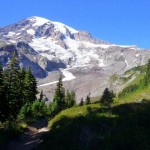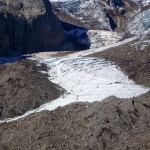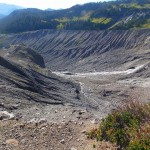| Area: Paradise | Hike Type: Glacier Views | Pass: Natl Park Pass |
| Distance: 3.25 mi RT | Duration: 2-3 hrs | Difficulty Level: Easy |
| Elevation Start: 5,020 | Elevation End: 5,820 | Elevation Gain: 800 |
| Snow-Free: Mid-July – Mid-Oct |
- the moraine trail drops to a moraine with mountain views
- the moraine
- another view from the moraine trail of the moraine
- portrait of mule deer moraine trail mrnp
The Moraine Trail must be one of Mount Rainier National Parks’ best kept secrets; the trail is often overlooked. Perhaps this is because many who visit the park come to climb Mount Rainier or Camp Muir, hike to Mazama Ridge, Panorama Point or any number of picturesque loops that start out on the Skyline Trail at Paradise. Others come to check out the Henry M. Jackson Visitor Center or in the summer months, to stroll the popular nature trails that are suitable for just about everyone.
Most hikes at Paradise begin on a paved cobweb of trails just above the Henry M. Jackson Visitor Center. On our recent visit in September, trail junctions were all well-signed and the trail in good condition.
The lesser-hiked Moraine Trail offers views of wildlife plus distinctive views of Mount Rainier and the Nisqually Glacier. Since the trail is often overlooked it has a wilder feel than the other nature trails at Paradise.
The hike begins above the Henry M. Jackson Visitor Center on the Skyline Trail – look for the stone staircase facing Mount Rainier – the stairway is engraved with a quote from the great naturalist, John Muir. At the top of the stairs you will come to the first of several well-signed junctions. Follow the signs to Dead Horse Creek – the first stretch of the hike can be crowded though mule deer didn’t seem to mind when we were there; they grazed peacefully beside the trail as we hiked.
When you come to a signed junction for the Moraine Trail; go left (off the paved trail). In about a half mile you’ll come to a metal sign advising hikers this is the end of the maintained trail; from that point proceed with a minimum of impact. After a short climb through meadows with purple bursts of late-summer asters and closer views of Mount Rainier the trail descends through groves of subalpine evergreens and small meadows sparkling with dew-splashed gentians, yellowing grasses and sedges. Or, depending on the time of year you explore this trail you may be feasting on the sensuous shapes of sparkling snow rather than colorful vegetation.
As you descend there are captivating views of the moraine formed by the Nisqually Glacier (the glacier is the headwaters of the Nisqually River which you crossed on your way to Paradise on the big road-bridge). Plus, the views of Mount Rainier are outstanding on a clear day.
The Moraine Trail cuts across meadows still lush enough in September to attract mule deer, marmots, golden-mantled ground-squirrels and pikas. Moraines are as fascinating as Mount Rainier itself; they are alive and ever-evolving as seasons shift and temperatures change. As we marveled at the views we wondered – where were the hikers on this beautiful, golden day? We were the only hikers on the trail, both coming and going.
Earlier in summer, these meadows are white with avalanche lilies eager to bloom as snow melts. That is a sight to behold though in October the meadows are more apt to be white with snow. Therefore we recommend an ice axe or trekking poles to get down to the moraine (otherwise content yourself with views from the trail) and never proceed beyond your comfort zone.
You can stop just about anywhere for those unobstructed views of Mount Rainier and the Nisqually Glacier when skies are blue. Depending upon your level of experience, weather and equipment you can continue further along the trail.
We continued our descent through meadows, crossed a dry tributary and followed the well-traveled path to the edge of the moraine. If you venture that far don’t get too close to the edge as the path there is eroding and under-cut in places; a fall would be dangerous. Besides, you don’t need to get to the very edge for a dramatic view of the headwaters of the Nisqually River as it trickles from the glaciers’ snout. Here you can see what a busy place this is; glaciers never hold still. Remember a glacier is essentially a frozen river that never stops flowing downhill, at times imperceptibly. Stand still and listen to the glacier “talk” as it shifts with creaks, groans, rumbles, snaps and crackles. Remember you are on Mountain Time here and Nature will not care if you venture off trail or lose your way in the enigmatic puzzle of glaciers and moraines. Stay on the path; if snow obscures the route it’s best to turn around. Mount Rainier, like any big peak, often “makes” its own weather, sun one moment, a white-out the next. Listen for rock-fall and avalanches higher on Mount Rainier – these can occur year-round. As we gaped at the views we felt like bystanders watching the construction (or destruction) of a skyscraper, this is a very exciting place to keep your eye on (from a safe distance, of course). Bring your camera and be prepared for sudden changes in the weather. On our way back we enjoyed the lingering warmth of the sun as the mule deer grazed beside the trail seemingly oblivious to the presence of hikers.
Additional Information: The recommended map: Mount Rainier Wonderland Trail (Green Trails No. 269S) or pick up a printed hand-out of the trail system at Longmire or the Henry M. Jackson Visitor Center (when open). Chains are required to be carried in all vehicles from November 1 through May 1. The appropriate pass (or fee) is required at park entrances.
– Karen Sykes
Waypoints
| Starting Point: N 46-47-04 W 121-44-27 | End Point: N 46-47-53 W 121-44-20 |
|
Notable Waypoints: Henry M. Jackson Visitor Center at Paradise: N 46-47-04 W 121-44-27 (5,400 feet) |
|





